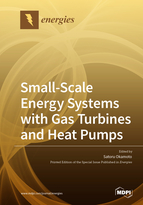Small-Scale Energy Systems with Gas Turbines and Heat Pumps
A special issue of Energies (ISSN 1996-1073). This special issue belongs to the section "J: Thermal Management".
Deadline for manuscript submissions: closed (29 August 2020) | Viewed by 25695
Special Issue Editor
Interests: advanced thermal and fluids science and technology: flow-induced vibrations; small-scale energy systems with gas turbines and heat pumps; experimental fluid dynamics; heat transfer; biomedical engineering; artificial intelligence
Special Issues, Collections and Topics in MDPI journals
Special Issue Information
Dear Colleagues,
The purpose of this Special Issue is to provide information on innovation, research, development and demonstration related to “Small-Scale Energy Systems with Gas Turbines and Heat Pumps.” The main focus of this Special Issue are conventional and non-conventional cooling, heating, and power technologies with gas turbines and heat pumps. Papers are solicited in areas including, but not limited to:
- Air-conditioning, refrigeration and heat pump systems
- Ab- and ad-sorption refrigeration machines and heat pumps
- Combined cycle, CHP, and CCHP with gas turbines
- Energy storage technology for gas turbines and heat pumps
- Renewable energy for gas turbines and heat pumps
- Design and modeling small-scale energy systems with gas turbines and heat pumps
- Evaluation and optimization of small-scale energy systems with gas turbines and heat pumps
- Economic and ecological analysis of small-scale energy systems with gas turbines and heat pumps
- Innovative small-scale energy systems with gas turbines and heat pumps
- Small-scale energy system applications
Objectives
Authors are invited to contribute to increasing international cooperation, as well as the understanding and promotion of efforts and disciplines in the area of “Small-Scale Energy Systems with Gas Turbines and Heat Pumps”. The dissemination of knowledge by presenting research results, new developments, and novel concepts in “Small-Scale Energy Systems with Gas Turbines and Heat Pumps” will serve as the foundation from which this area will be developed.
A variety of topics are available for presentations, allowing authors flexibility.
Prof. Emer. Dr. Satoru Okamoto
Guest Editor
Manuscript Submission Information
Manuscripts should be submitted online at www.mdpi.com by registering and logging in to this website. Once you are registered, click here to go to the submission form. Manuscripts can be submitted until the deadline. All submissions that pass pre-check are peer-reviewed. Accepted papers will be published continuously in the journal (as soon as accepted) and will be listed together on the special issue website. Research articles, review articles as well as short communications are invited. For planned papers, a title and short abstract (about 100 words) can be sent to the Editorial Office for announcement on this website.
Submitted manuscripts should not have been published previously, nor be under consideration for publication elsewhere (except conference proceedings papers). All manuscripts are thoroughly refereed through a single-blind peer-review process. A guide for authors and other relevant information for submission of manuscripts is available on the Instructions for Authors page. Energies is an international peer-reviewed open access semimonthly journal published by MDPI.
Please visit the Instructions for Authors page before submitting a manuscript. The Article Processing Charge (APC) for publication in this open access journal is 2600 CHF (Swiss Francs). Submitted papers should be well formatted and use good English. Authors may use MDPI's English editing service prior to publication or during author revisions.
Keywords
- Air-conditioning, refrigeration and heat pump systems
- Ab- and ad-sorption refrigeration machines and heat pumps
- Combined cycle, CHP, and CCHP with gas turbines
- Energy storage technology for gas turbines and heat pumps
- Renewable energy for gas turbines and heat pumps
- Design and modeling the small-scale energy systems with gas turbines and heat pumps
- Evaluation and optimization of small-scale energy systems with gas turbines and heat pumps
- Economic and ecologic analysis of small-scale energy systems with gas turbines and heat pumps
- Innovative small-scale energy systems with gas turbines and heat pumps
- Small-scale energy system applications






